The mobile app and software development sector has taken a high jump on the growth ladder with the rise of sophisticated technologies. With this advancement, the development process of apps and websites has also evolved. They are now built using various technology stacks. These stacks help in developing highly updated websites and apps with complex features easily. So let’s talk about the top 10 most popular web development frameworks.
The development of apps and websites is supported by frameworks which are libraries that enable effortless development. With the emerging technology, a lot of web developer frameworks have emerged in the market which makes it difficult to choose the suitable one for your projects. As a Full Stack Developer, it is essential to have knowledge about the top Full Stacks available. Below is the list of the top 10 popular Full Stack web development frameworks that you can work with:
1. MEAN
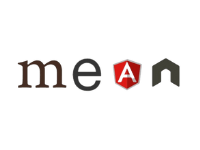
MEAN is one of the most popular open-source full stacks for web app development that offers numerous benefits to developers. It is a set of JavaScript-based technologies and comprises of
- MongoDB for a document database
- Express.js for a web framework
- Angular.js for frontend development
- Node.js for backend development
MEAN stack is used for developing complex web apps and websites that are scaleable and optimized for cloud deployment.
| Advantages of using MEAN | Disadvantages of MEAN |
| Easy to switch between server and client: With MEAN developers have to write the code in one language only i.e. JavaScript, which works for both client and server-side requirements. If you are good at JavaScript, you can manage a project entirely on MEAN and deploy the app directly on the server. | Server isolation from business logic is poor: Express.js has poor server isolation which prevents the reuse of certain services like batching operations. For internal jobs, you have to go through the express middle chain, which can be inconvenient for MEAN users. |
| Allows real-time demonstration: MEAN allows real-time changes to the app during the development process as well which makes it super convenient for developers. | Allows real-time demonstration: MEAN allows real-time changes to the app during the development process as well which makes it super convenient for developers. |
| Supports MVC structure: MEAN stack is capable of complying with the Model-View-Controller(MVC) architecture which gives the developers the freedom to deal with multiple programming languages. | Not better than relational databases: MEAN does not provide the same level of functionality as the relatable databases, which are more stable and reliable. |
Use Case
MEAN is a strong choice for developing cloud-based applications because of its ability to manage concurrent users and scalability. Angular.js makes it ideal for developing single-page apps that display all the required information and functionality on a single page. You can use it for:
- Expense tracking
- Calendars
- News sites
- Location finding or mapping
2. MERN

MERN stack JavaScript web developer framework is used for faster and easy deployment of web apps. It uses the following technologies:
- MongoDB for database
- Express for Backend framework
- React for frontend
- Node for JS runtime environment
These technologies provide the developers with an end-to-end framework to work on developing excellent web apps.
| Advantages of MERN stack | Disadvantages of MERN stack |
| UI rendering and performance: When it comes to UI layer abstraction, React is the best. It gives you the freedom to organize code and build the app however you want. | Large-scale apps: MERN is best suited for single-page apps. It becomes difficult to work on large projects that involve many developers. |
| Easy to switch between server and client: MERN is simple and fast because it is written in one language which makes switching between server and client easy. | Low Productivity: React uses many third-party libraries which lowers productivity and this demands more effort. |
| Open-source: All the technologies in MERN are open source which makes getting solutions for queries, easy. | Lags behind in Preventing errors: Unlike MEAN, MERN lags behind in preventing errors by its own design. |
Use Cases
MERN is ideally suited for JSON-heavy, cloud-native, and dynamic interface apps. You can use it for
- To-do apps and calendars
- Workflow management
- News
- Social products
- Interactive forums
3. MEVN
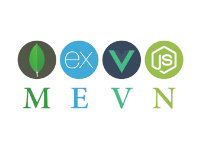
MEVN is a web stack like MEAN and MERN which uses new front-end technology Vue.JS, which is the only different component in MEAN, MERN, and MEVN. It is fast and is easy to learn as well.
| Advantages of MEVN stack | Disadvantages of MEVN stack |
| Easy switch between client and server: Like MEAN and MERN, MEVN also uses JavaScript at all levels of development which makes the process efficient and faster enabling easy to switch between the client-side and server-side easily. | Lesser community support: Since Vue.JS is new, as a developer you will not find large community support compared to other best frameworks for a full stack. |
| MVC architecture: MVC architecture organizes the server-side which makes back-end development efficient and faster. | Not flexible: Vue.JS is not flexible when it comes to working with multiple developers on large projects. |
| Easy to learn: Vue.JS is easy to learn and is faster when it comes to front-end development saving a lot of effort on part of the developer. | Multi-object transactions: MongoDB is not suited for multi-object transactions and only supports ACID. |
Use case: It has a similar use case as MEAN and MERN
4. RUBY

Ruby is a high-level object-oriented programming language that uses garbage collection. It is a dynamic language and is based on many other languages like Lisp, Perl, Smalltalk, Ada, and Eiffel. It is easy to read and write codes in Ruby because the syntax is similar to Java and C.
Since the Ruby programming language is an interpreting language, it does not requires a compiler to translate the code into machine language. Developers using Ruby also get a powerful package manager RubyGems.
| Advantages of RUBY | Disadvantages of RUBY |
| Object-oriented programming language: This means that RUBY allows developers to build, debug, reuse and maintain software easily. | Slow speed: Speed has been the main drawback of this language when compared to others. It does not serve well when writing real-time control systems. |
| Gems: RUBY gems are ready-made solutions that extend the functionality which means that developers don’t have to write code from scratch. | Poor debugging: Since it generates bugs at runtime, debugging in Ruby is difficult. |
| Elegant syntax: RUBY is easy to read and write because of the easy syntax that makes learning it effortless. |
Use Case
RUBY is popularly used to create custom marketplace websites. You can use RUBY for
- Content management solutions
- SaaS products
- Prototyping
- Custom Database solutions
5. Angular.js
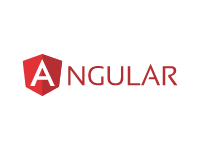
Angular.js is an open-source Java MVC framework for dynamic web app development. It is one of the web development frameworks because it allows you to create a rich client-side interaction. It allows easy data binding and can be done by adding a few snippets of codes. Angular.js helps developers to build architecture-level applications and is packed with a number of frameworks and plugins. It uses a typescript programming language based on JavaScript.
| Advantages of Angular.js | Disadvantages of Angular.js |
| Two-way data binding: With Angular.js you can make data-related changes and it would be immediately propagated in the views. Any change in the view will make a change in the underlying model. | Requires Angular.js specific libraries: Angular.js does not work well with libraries and tools that are not Angular.js specific. It increases the testing time if you have several JavaScript iterations even on a single-page app. |
| Smooth navigation: Angular.js uses a simple MVC structure which decreases the page load time. It also eradicates the unnecessary codes allowing faster development of the web app. | Complicated framework: In Angular.js there are numerous ways to perform a task. It sometimes becomes difficult to predict which is the most optimized way. |
| Requires less coding: Angular.js offers a declarative framework. It eliminates the requirement of writing long complicated codes and provides a simple data model. | Less secure: Angular.js does not have server authentication or authorization. |
Use Case
It is used for creating dynamic single-page web applications. You can use it for creating
- User Review apps
- On-demand video streaming apps
- Travel apps
- Content portals
- Weather apps
- Enterprise web apps
6. React.js
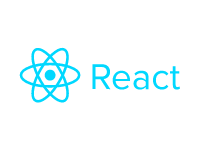
React.js is an open-source JavaScript library that enables the creation of unique, engaging, and user-friendly web applications with very minimal requirements of coding. It allows you to create huge websites and apps that can easily curb data without reloading the page. It works with the user interface and communicates with the MVC template.
| Advantages of React.js | Disadvantages of React.js |
| Easy to learn: Anyone with JavaScript knowledge can learn React.js. It is both easy to learn and use. There are a lot of tutorials, documentation, and training resources available. | Poor documentation: React.js is updated regularly with new releases and tools which leaves no time for proper documentation. Developers write their own instructions to overcome this issue in their projects. |
| Reusable components: React.js allows you to reuse the components, that are independent of each other. It also allows you to nest them with other components for simplifying the process of developing complex web apps and saving your time writing codes. | Limited to front-end: React.js is only limited to the UI layer of the web app which means that as a developer you will have to choose other technologies as well for getting complete tooling set for the web app development. |
| Makes Dynamic websites easily: React.js makes creating dynamic web apps easily without having you code a lot and also offers more functionality. React.js supports building machine-readable codes. |
Use Cases
React.js fits perfectly for developing dynamic social media apps. Apart from this, you can also use React.js for
- E-commerce or retail apps
- Data visualization tools or dashboards
- Business websites
- Galleries
- Rating websites
- E-learning
- Media-centric web apps
7. Node.js
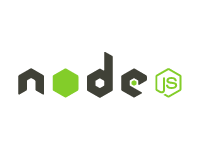
Node.js is a JavaScript environment that assists in server-side execution. It is open-source and helps in developing real-time network apps. Node.js helps in building scalable and fast network apps using easy-to-understand codes.
| Advantages of Node.js | Disadvantages of Node.js |
| Scalability: This is one of the most loved features of Node.js and makes it popular. It allows you to grow the application by adding extra nodes to the existing system. For scaling the application, Node.js allows you to add extra resources to single nodes. | Lacking library support system: JavaScript lacks a powerful and well-equipped library system that compels you to use common libraries for ORM, image processing, database operations, etc. |
| Fullstack: Node.js is capable of working on both the client and server sides of the application. | Inconsistent programming interface: This is a common complaint of developers that the API is Node.js changes frequently. The new API modifications are sometimes not compatible with the previous version which forces the developers to make changes to the code base for compliance with the new version. |
| Single language: Node.js uses JavaScript for both front-end and back-end which means that you don’t have to use a separate server-side programming language. This makes deploying the app easy as JavaScript runs on almost all web browsers. |
Use cases
Node.js can be used in web development for many industries like
- Banking
- Retail
- Telecommunication
- Healthcare
- Media and broadcasting, etc.
8. Vue.js

Vue.js is a JavaScript framework that is used to develop an interactive user interface. It is an easy, flexible and lightweight framework that meets the need for advanced web application development. Vue.js is easy to integrate for the front-end development of big projects and is also capable of powering single-page apps when used with the combination of support libraries and modern tools.
| Advantages of Vue.js | Disadvantages of Vue.js |
| Small size: Vue.js is a JavaScript framework that is just 20KB in size. Despite the small size, Vue.js is fast and outperforms the bulky frameworks for web development. | Lack of support: Vue.js is a new language and thus, there is very limited support available around this framework. |
| Simple: Vue.js is a very simple-to-use framework. Developers with knowledge about JavaScript can easily use Vue.js. It allows you to code more in a few lines. | Limited plugins: Since Vue.js is new and is still in the developing phase, it still does not supports many plugins. However, Vue.js can be combined with Angular or React to solve this issue. |
| Integration: Ease of integration is one major advantage that makes Vue.js popular. It is easily integrable with existing apps. It can be used for building an entire single-page app and for bringing new components to an existing app as well. |
Use Cases
Vue.js is perfect for creating large single-page web apps. You can use it for
- Social media websites
- Repository manager
- Navigation menu
- Todo Apps
- Instant search
- Order form, etc.
9. Spring Boot
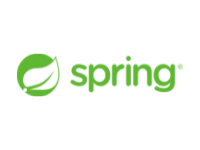
Spring Boot is a popular Java-based open source enterprise-level framework that helps in creating standalone and production-grade apps. It allows developers to start coding right away with minimum configuration as it provides defaults for configuration annotations and codes. It provides flexible XML configurations in contrast to Java web developer frameworks along with database transactions, easy workflow, and other tools.
| Advantages of Spring Boot | Disadvantages of Spring Boot |
| Reduces development time: Spring boot reduces the requirement of writing multiple boilerplate codes, annotations, and configurations which ultimately saves a lot of time and configures the necessary files automatically. | Less control over the system: This has been a major complaint of developers about Spring Boot. Since it allows less control over the system, it installs extra dependencies assuming that the system would need them. This in turn can increase the binary size of the Spring Boot App. |
| Easy integration: It is very easy to integrate Spring Boot applications with the Spring Boot ecosystem that includes ORM, Spring Security, Spring JDBC, Spring Data, etc. | |
| Easy testing: Spring Boot allows you to test the app easily with the help of embedded HTTP servers like Jetty, Tomcat, and many others offering a lot of flexibility in back-end app development. |
Use Cases
Spring Boot can be used for the following
- Developing cloud-native apps
- REST API development
- Auto/ manual scheduled jobs
- A&A Security
- API performance for redundant data request
- Control API traffic, etc
10. Flutter

Flutter is an open-source UI framework created by Google. It allows you to create native mobile apps using only one code base which means you only need one codebase and one programming language for creating two different cross-platform apps. Flutter consists of SDK and reusable UI elements for app development. It uses Dart as its programming language.
| Advantages of Flutter | Disadvantages of Flutter |
| Cross-platform: Apps created using Flutter run on both iOS and Android. It does not require any redesigning or reconfiguration. | Limited library: Flutter offers a limited library. They do not provide all functionalities and thus the developers are required to develop functionalities themselves. |
| Powerful design: Flutter helps in designing powerful apps with fewer efforts. The apps developed using Flutter can stably deliver 60 frames/ second. | No web browser support: Apps developed on Flutter only support Android and iOS. |
| Saves time and money: Flutter reduces the requirement of the number of developers saving them the cost and since it is a very efficient cross-platform framework, it saves time as you only have to work on one app that works on both platforms. |
Use Cases
Flutter has gained popularity in a very short time and is used by Alibaba, Airbnb, and other companies. You can use Flutter for creating apps on
- Fintech and banking
- Retail
- Large businesses
- Franchises
- Suppliers, etc.
With the extensive growth in technology, the number of new frameworks and tools has also amplified. The above-mentioned web development frameworks will help you to choose the best Full stack and framework based on the project requirement. While you learn these, it is important to stay updated about the latest launched technologies if you want to be an expert in Full Stack development.
FAQ’S
Ans – Yes, Full Stack is one of the most demanded professions these days, and are paid handsomely. With good skills and experience, you are likely to get a job in top IT companies.
Ans – It is possible to learn Full Stack Development in 6 months but it absolutely depends on your learning speed and consistency. Learning these languages requires a good amount of effort & time. With full dedication, you can learn these languages and technologies faster.
And – A Full Stack Developer is a person who manages both frontend development and backend development and thus should be well versed in both frontend and backend technologies. You should have good knowledge of frontend languages and technologies like HTML, CSS, JavaScript, and backend technologies like Java, PHP, Django, Ruby, NodeJS. You should be aware of databases like SQL, MongoDB, etc. along with version controls like GIT and GITHUB.
Ans – As a Full Stack Developer, you can learn many programming languages. However, HTML, CSS, and JavaScript are the most used languages in Full Stack Development. Apart from these, you should also know Java, C or C++, and Python.

